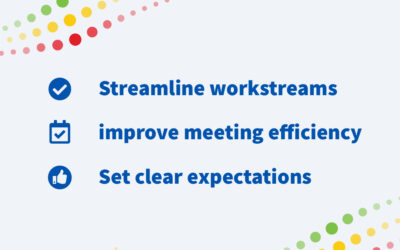Implementing a School Improvement plan is hard work and most educators don’t have formal training or the systems in place for implementing an improvement plan. Add to this the fact that, for at risk schools there is a ticking clock at play and pressures can amplify quickly
Once your school or district has a School Improvement plan, you need a progress management system to meaningfully and effectively implement the plan.
Specifically designed for School Improvement, progress management software can empower a school to reach the student outcomes the plan is designed to improve by:
- Organizing the plan and making it accessible
- Managing the process
- Measuring the impact on a real time basis
- Enabling your staff to collaborate and pivot when necessary
This article and videos will review some of the challenges of implementing a School Improvement plan, explain why home grown tools or standard project management software are not enough, and discuss the benefits of using school improvement tools built by educators and designed specifically for educators.
The Top Barrier to Producing Desired Outcomes
To create a school improvement plan you and your team need to invest your resources, time, passion and political capital. It’s also very likely that you’ve engaged with outside experts and partners to help create your plan.
But creating a plan isn’t enough. Improvement plans fall short because the essential link between planning, implementation and student outcomes is broken. What do we mean by this? Well, as educators, we’re really good about setting goals and we’re getting better about defining the strategies that we use in service of those goals, but then school happens.

The realities of life in a district or a school takeover and the connection between educator efforts and student impacts break. We find ourselves at the end of the semester of the year looking back and trying to work out what parts of the improvement plan were implemented, what parts were not, and what impact any of it had on our students.
The Challenges to Past Approaches
Historically, schools and districts have used Student Information Systems to get important insight into their student outcomes. And some schools have tried using project management or other productivity tools to track their educational practices. But working in separate systems makes it very difficult to understand how specific educational practices and actions are actually impacting student outcomes. You can see the outcomes but the actions you are taking and the outcomes aren’t connected in real time.
Some districts have spent large amounts of staff time building and maintaining their own homegrown progress management tools, usually combining spreadsheets and document sharing software. In rare cases these custom built tools and solutions may let leadership teams compare some actions and progress indicators in their improvement plans but these homegrown systems are:
- Difficult to manage
- Error prone
- Expensive to maintain (sometimes needing dedicated staff)
- Limited in their functionality
- And can make data reporting difficult and real time analysis impossible
Manual, non-real-time, solutions with data spread across multiple systems reduces educator effectiveness and has a negative impact on student outcomes:
- For the teachers who are actually doing the hard work described in the improvement plan the expectations can be unclear. And communicating and updating the plan or actions can take so much time in meetings there is usually not time for real collaboration and problem-solving. Time spent with colleagues is an amazing opportunity to collaborate and problem solve – but too often that time is used for just reporting out and not on working through challenges.
- For Superintendents and Administrators it can be very difficult to compare programs across multiple schools, and to see which programs are working and which programs may need additional supports.
- For Principals it can be very difficult and time consuming to get insights into everything that is happening in their school. And the depth and quality of the information can have limited context and vary significantly from person to person
The work of school improvement is incredibly difficult. Without a systematic performance and progress management approach you risk frustration and inefficiency which can ultimately lead to the improvement plan just not happening.
How Does a Progress Management System Make Your Staff More Effective
Changing student outcomes requires changes to educator inputs. Successful school improvement requires you to systematically implement your plan because simply put – if nothing changes, nothing changes.
A progress management solution empowers you to set clear expectations and focus all of your stakeholders on the same goals. This allows your team to create action plans in a safe and supportive environment with actionable real-time data in custom reports for all of your stakeholders.
Gets your plan into a system that everyone can see
The first step is getting your plan off the written page and into a system. Flipping through a large document to understand the plan takes time and effort that most of your staff does not have to spare. A progress management system allows your team to access the parts of the improvement plan that are most relevant to them.
Sets clear expectations and goals
Once your staff has access to their specific areas of your Improvement Plan in RespondAbility it’s easy for them to understand what goals, targets and specific tasks they are responsible for and on what timeline. Most importantly they understand how their actions are tied to the goals of the School Improvement Plan.
Make reporting easy and effective for your team
A progress management system makes it easy to report on progress. Using RespondAbility reporting takes each individual about 4 minutes a week. This quick and frequent reporting has the added advantage of turning meetings into problem solving events, instead of reporting events where problem solving cannot happen because of time constraints.
Smarter decision making with real time visibility
Real time dashboards and reports help teams and leadership to consistently monitor the plan, analyze the impact the plan is having and then identify course corrections so that the improvement plan has the desired impact on student outcomes.
Allows leadership to support staff where necessary
Once leadership sets clear expectations with their teams reporting can be automated. With all the data tied together in real time you can also use metrics to understand what actions are having an impact on student outcomes and what actions are not. This means leadership can focus their time, support and additional resources where they can have the greatest learning impact.
Build a collaborative culture
With the logistics of reporting and compliance minimized and everyone focused on student outcomes you can foster an environment which can celebrate successes and address challenges with a shared and aligned sense of purpose.
Summary
The work of school improvement is incredibly difficult without a systematic performance management approach. It can lead to frustration and inefficiency which can ultimately lead to the improvement plan just not happening. A performance management system can help you to:
- Turn your school improvement plan into a living document
- Implement and collaborate on school improvement actions
- Monitor and adjust your school improvement plan based on the impact to student outcomes
By changing the inputs you can change the way your team engages with the improvement plan, create positive momentum, and have the desired impact on student outcomes.
RespondAbility is a cloud based progress management platform built by educators for educators that helps superintendents, principals, and teachers implement their school and district improvement plans in the most powerful and effective way possible.




